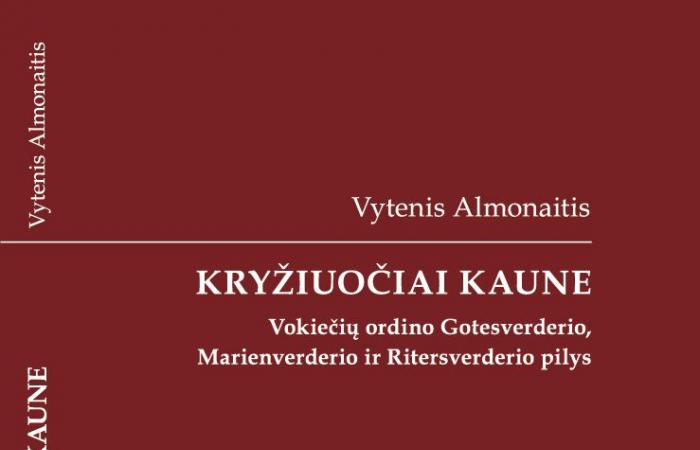Book cover. Photo of the “Traveler’s Guide” publishing house.
www.voruta.lt
At the beginning of 2024, the scientific monograph “Trusaders in Kaunas: Castles of Gotesverder, Marienverder and Ritersverder of the Teutonic Order”, written by historian Vytenis Almonaitis and published by the publishing house “Keliautojo žinynas”, appeared in bookstores. The book has 208 pages, but, with a frugal layout, they contain about 340,000 text of printing marks, 36 illustrations, so it is a large-scale scientific work. How innovative it is is shown by the fact that only a few pages out of 400 are devoted to the subject in V. Almonaitis’ monograph in the capital “History of Kaunas” by Zigmantas Kiaupas, which covers the period up to 1655.
The research is based on written and other sources. Among them, the Marienburg treasurer’s book stands out for its informativeness. It was known to Lithuanian historians, but has been little used until now. After examining this source, V. Almonaitis noticed that in 1398 the rebuilt Gotteswerder Castle is mentioned in it as many as 78 times. The monograph reviews the works of other historians who wrote about the castles under study. Some of them, for example, the works of the US historian William Urban, are evaluated quite critically.
As the title of the book indicates, it focuses on three Teutonic castles that existed between 1369 and 1402. period. All of them were built by the German Order, after destroying the Lithuanian Kaunas Castle, in order to gain a foothold in a strategic place – in the area of the confluence of Nemunas, Neris and Nevėžio. In fact, the monograph also describes the years 1363-1369. battles for the Lithuanian castle of New Kaunas, so the chronological frame of the research is four decades significant for the history of Kaunas and the whole of Lithuania.
During those 40 years, the German Order tried to build its fortress in or near Kaunas four times. So the structure of the book is logical: in addition to the introduction and conclusions, there are four chapters. The first one describes the year 1369. built until approximately 1384 Gotteswerder Castle was used, in the second – 1384. the short-lived Marienverder fortress arose, in the third – 1391-1392. Riterswerder Castle was used, in the fourth – 1398. was also rebuilt in 1402. the fallen second castle of Gotteswerder. The texts of all four chapters are supplemented by clippings from old maps, photographs, but the most additional information is provided by the diagrams of German and Lithuanian castles compiled by the author. They perfectly reflect the situation in Panemuna in 1363-1369, 1384, 1385-1394, 1395-1402. the situation in Panemuna.
The development of castles in the monograph is consistently analyzed from the beginning of construction to their collapse. It is written about their equipment, crews, daily life, preparation for defense, the capture of castles by the Lithuanian army and the significance of these events. The events are discussed in the wider context of the war between the Grand Duchy of Lithuania and the Teutonic Order.
It is important and emphasized that all three castles are attempted to be localized. V. Almonaitis concludes that the castle sites of Gotesverder and Marienverder, or at least most of them, were probably washed away by the rivers. In the case of Ritterswerder, the author indicates the possible location of the castle in Lampedžii and publicly invites archaeologists to continue his research.
The author and the publishing house were helped by a group of assistants. The text was edited by Jonas Varnauskas, the book was laid out by Skaidra Vaicekauskienė, the illustrations were prepared by Junona Almonaitienė, the summary was translated into English by Daiva Radžiūnaitė, the cover was created by Rita Brakauskaitė and Domantas Almonaitis, who also drew the aforementioned diagrams. The book was printed in an exemplary manner by the “Petro offsetas” printing house.
The book has already gained and, apparently, will gain a large number of readers. How necessary it was for society is shown by the fact that in 2024 February 9 About 250 people participated in the presentation of the monograph, which took place in Kaunas, Lithuanian officers’ barracks.
“Voruta” information
Tags: monograph exceptional decades Kaunas history
-





